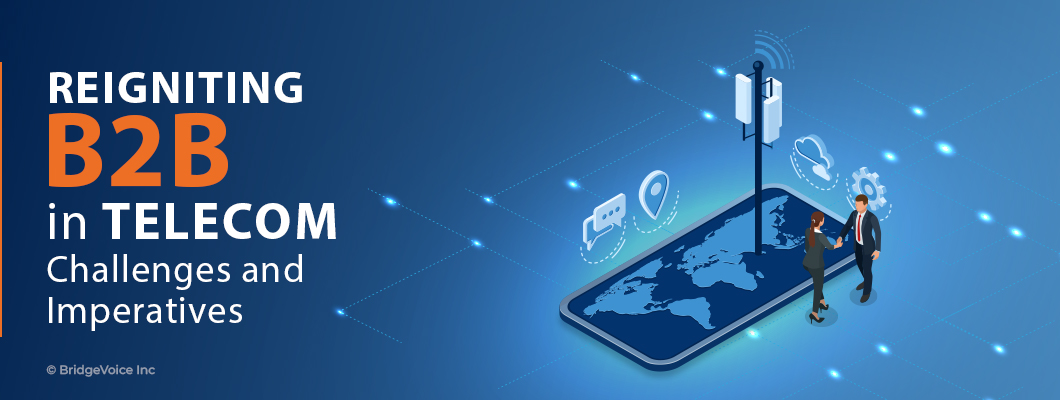Reigniting B2B in Telecom: Challenges and Imperatives

As Industry 4.0 is around the corner, the shift from telcos to techno opens up possibilities for telecom players to renew their focus on their B2B portfolio. Communications Platform-as-a-Service (CPaaS) has already paved a path for enterprise infrastructure. Such a platform allows complete control over wholesale voice and message services like DID service (Direct Inward Dialing and Inbound Service), IVR (Interactive Voice Response), billing, and more.
The B2B telecom market is forecasted to reach $181.35 billion by 2030 from $46.36 billion in 2020, burgeoning at a CGAR of 14.8%. Telcos will make value propositions for their enterprise customers by adding new domains to their portfolio driven by 5G, cloud edge services, VoIP, M2M (Machine-to-Machine) communication, data intelligence, and unified communication.
Communication service providers will move many industrial verticals from the siloed marketplace to a connected one with integrated end-to-end use cases and project-based cross-industry solutions. Let’s look at B2B opportunities for telcos and how they can build new-age connectivity.
Key Trends Bringing Enterprise Opportunities to Telecom Operators
The Emergence of 5G
The emergence of 5G technology will create additional revenue streams for telcos in IoT and digitization economy. It will birth new business models where communication providers will be more than just connectivity providers.
5G will transform the intranet into a more sophisticated extranet where enterprises can leverage 5G private networks to deploy use cases across their full supply chain. As a result, telcos will become a connectivity platform offering vertically integrated industry solutions, like connected manufacturing, healthcare, and more.
XaaS Adoption in Telcos
Soon, subscription services for connectivity and communication will represent only a small part of telecom operators’ revenue mix. Many telcos will seize XaaS (Everything-as-a-Service) opportunities to cater to large B2B segments.
Operators will differentiate themselves by offering a network as a platform where enterprise customers can dynamically determine service contracts. For example, banks pay carriers for enhanced security against ATM frauds.
Connectivity on the Go
Many products like CAVs (Connected and Autonomous Vehicles) come with pre-built connectivity infrastructure that allows devices to get smarter over time.
Many still use Wi-Fi for connectivity, but as ‘Smart City’ and IoT deployments continue to grow, telcos can charge manufacturers for connectivity costs to launch products with connectivity-on-the-go.
Telcos can also offer in-house connectivity for predictable industrial maintenance and optimized manufacturing.
Challenges and Imperatives of New Age Enterprise Connectivity
5G-ready BSS for Better B2B Customer Experience
Superior app performance, real-time data insights, improved productivity, and accelerated process automation are some expectations of enterprises from the new age telcos. Telcos must establish a BSS (Business Support System) that delivers a smooth and simple B2B customer experience.
Here’s how:
- Intuitive enterprise interaction system for frictionless customer and partner engagement
- From order to activation, an automated catalog-driven architecture
- Openness and accessibility through standardized APIs
- End-to-end journey management on a digital BSS platform
- Simplified CX using a cloud-native micro-services architecture
Evolved Spectrum and Fiber Capabilities
The spectrum and fiber portfolio are the most critical resources for any communication service provider. With a robust and evolved spectrum and fiber strategy, an operator can achieve a low-cost structure and tap into the enterprise market and new technologies faster.
Conversely, poor management of spectrum and fiber assets can hinder a company’s sustainable growth and profitability in the B2B ecosystem.
Bundling Connectivity Through Platform-based Models
The new connectivity age is about evolving the core telecom business to a platform-based connectivity model. Telecom operators can launch new services, such as SD-WAN (Software-Defined Wide Area Network), MEC (Multi-access Edge Computing), IoT, and security through this platform.
Communications companies can leverage 5G, programmable network, and edge functionalities to provide bundled connectivity services with guaranteed network and infrastructure SLAs (Service-Level Agreements). For example, offering a bundle of IoT and data processing solutions that combine data from vehicle logs, smartphones, and event metrics to predict the demand for cabs in particular areas while safeguarding legal compliance.
Configuring Scalable ICT Infrastructure
Telcos need an integrated ICT (Information and Communications Technology) portfolio that enables solutions based on industrialized building blocks. Such an integrated ICT portfolio can be created by disassembling and defining modularized offerings and billable components.
This approach will enable standardized, scalable, and sustainable B2B processes, entailing cost-optimized IT stacks. Therefore, it will make a stronger B2B value proposition.
Acquiring and Partnering
Telecom operators will need to explore many options to execute the new age of enterprise connectivity. Acquisitions, joint ventures, and strategic partnerships for design thinking and co-creation will be the key to scaling the new B2B portfolio.
It will be the last step toward orchestrating connected solutions for industry value chains. Telcos with industry-specific service providers, ICT providers, cloud providers, and a broader ecosystem of partners can build mission-critical B2B applications, such as remote surgery and autonomous vehicles.
Capture Enterprise Opportunities Using CPaaS Carrier Platform
After facing competition with OTT players and cloud giants, telecom operators are finally presented with unprecedented enterprise opportunities driven by 5G, XaaS, and IoT. If telecom operators want to monetize B2B opportunities, they must create a host of new cloud-connected, platform-based business models. If done right, keeping in mind these imperatives, telcos can orchestrate solutions across industry value chains and be formidable ecosystem players.
BridgeVoice is a leading DID number provider that uses the CPaaS platform to offer full control over DID service and other premium VoIP features.

 Fostering Authentic Connections: The Power of P2P SMS-Enabled Numbers and DID Services in Customer Engagement
Fostering Authentic Connections: The Power of P2P SMS-Enabled Numbers and DID Services in Customer Engagement